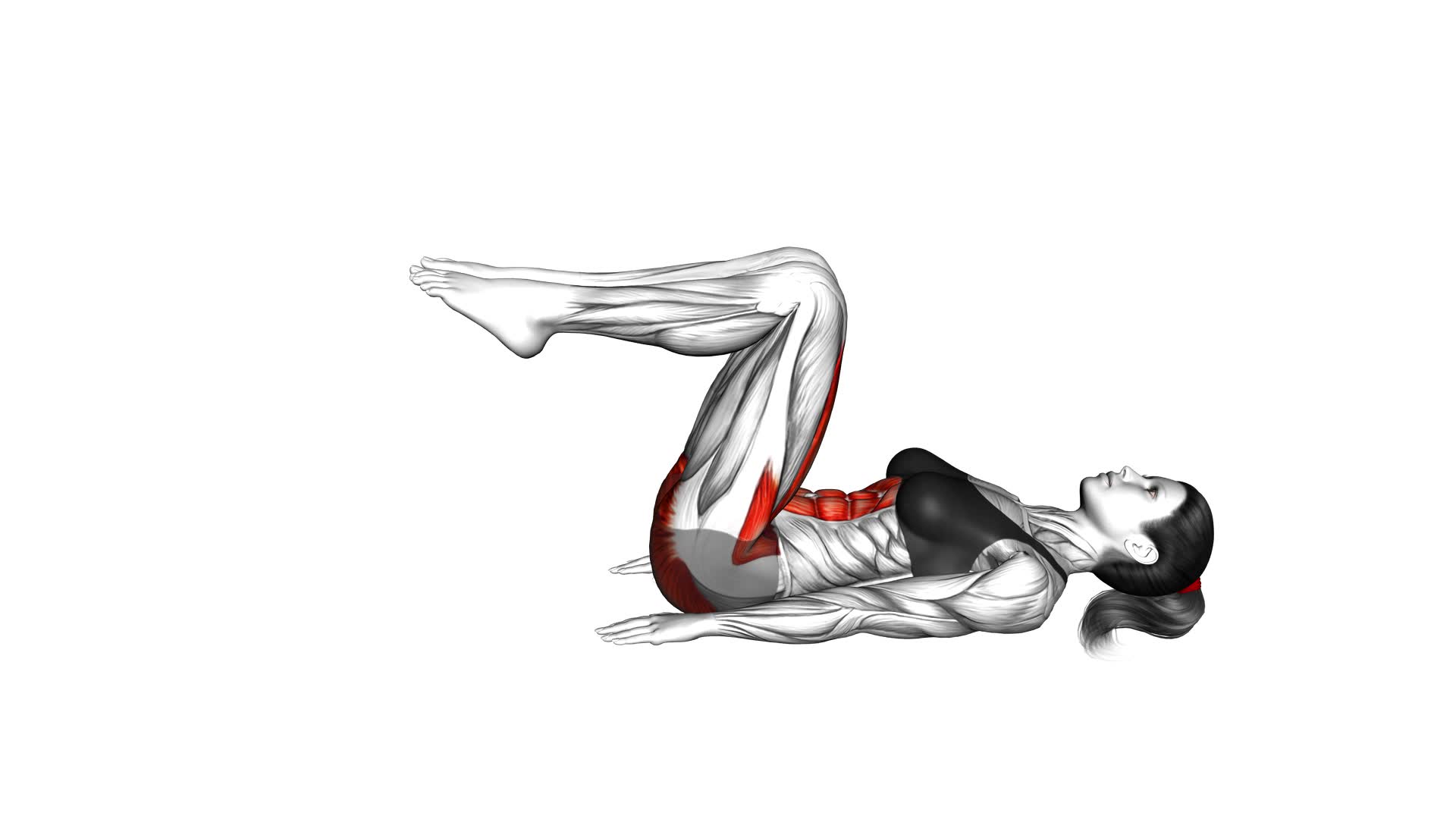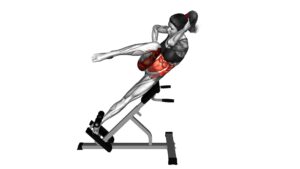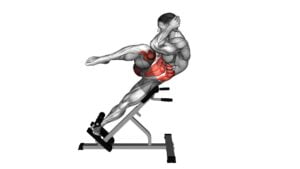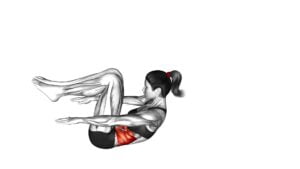90 Degree Single Knee Crunch (female) – Video Exercise Guide & Tips

Looking to tone your abs and strengthen your core? The 90 Degree Single Knee Crunch is the perfect exercise for you!
Watch This Exercise Video
In this video exercise guide, we'll show you proper form and technique, as well as modifications for all fitness levels.
Avoid common mistakes and maximize the effectiveness of this crunch with our expert tips.
Get ready to feel the burn and achieve your fitness goals with this targeted workout move.
Let's get started!
Key Takeaways
- The 90 Degree Single Knee Crunch strengthens abdominal muscles and targets core muscles.
- Proper form and technique are important to maximize the benefits of this exercise.
- Modifications and variations can be made to accommodate different fitness levels.
- Common mistakes to avoid include improper form, using momentum instead of controlled movement, and neglecting proper breathing technique.
Benefits of the 90 Degree Single Knee Crunch
One benefit of the 90 Degree Single Knee Crunch is the strengthening of your abdominal muscles. This exercise specifically targets your core muscles, helping to increase overall core strength. By performing the 90 Degree Single Knee Crunch, you engage your rectus abdominis, obliques, and transverse abdominis, which are all important muscles for maintaining stability and proper posture.
The 90 Degree Single Knee Crunch is a highly effective exercise for building core strength because it requires you to stabilize your body while moving your legs. This combination of stability and movement forces your abdominal muscles to work hard to maintain control and balance. As a result, your abdominal muscles become stronger and more toned over time.
In addition to strengthening your abdominal muscles, the 90 Degree Single Knee Crunch also helps to improve your overall core stability. This is important for athletes, as a strong and stable core can enhance performance in various sports and activities. Additionally, a strong core can help prevent injuries by providing support and protection to your spine.
Proper Form and Technique for the Exercise
To perform the Degree Single Knee Crunch with proper form and technique, it's important to focus on core engagement techniques. Keep your core muscles tight and controlled throughout the exercise, avoiding any unnecessary movement or momentum.
Common form mistakes to watch out for include:
- Pulling on the neck
- Using too much hip flexor instead of abdominal muscles
- Not fully extending the leg.
Core Engagement Techniques
To properly engage your core during the Degree Single Knee Crunch exercise, focus on contracting your abdominal muscles throughout the movement. Here are some core engagement techniques to help you get the most out of this exercise:
- Core activation:
Start by lying on your back with your knees bent and feet flat on the floor. As you lift your upper body off the ground, imagine pulling your belly button towards your spine to engage your core muscles.
- Breathing techniques:
Exhale as you lift your upper body off the ground, and inhale as you lower it back down. Focus on deep, controlled breaths to help stabilize your core and maintain proper form.
By incorporating these core activation and breathing techniques, you can maximize the effectiveness of the Degree Single Knee Crunch exercise.
Now, let's move on to common form mistakes to avoid for optimal results.
Common Form Mistakes
To ensure proper form and technique for the Degree Single Knee Crunch exercise, it's important to avoid these common form mistakes. First and foremost, focus on proper breathing techniques throughout the exercise. Exhale as you crunch up and inhale as you lower your body back down. This will help engage your core muscles effectively.
Additionally, be mindful of avoiding strain on the neck and shoulders. Keep your neck relaxed and avoid pulling on it while performing the crunch. Instead, focus on engaging your abdominal muscles to initiate the movement.
By maintaining proper form and technique, you can maximize the effectiveness of the exercise and minimize the risk of injury.
Now, let's move on to exploring modifications and variations for all fitness levels.
Modifications and Variations for All Fitness Levels
Now let's explore the modifications and variations that can be made to the Degree Single Knee Crunch to suit all fitness levels.
Whether you're a beginner looking for adaptations or an advanced exerciser seeking progressions, there are options available to challenge or modify the exercise according to your needs.
Adaptations for Beginners
Start by gradually increasing the range of motion for the Degree Single Knee Crunch, allowing for modifications and variations to accommodate all fitness levels.
Here are some beginner modifications and common beginner mistakes to watch out for:
- Modify the exercise by reducing the range of motion: If you're just starting out, you can begin by only lifting your shoulders slightly off the ground and focusing on engaging your core.
- Use a stability ball for support: Placing a stability ball under your lower back can provide extra support and stability for beginners.
- Avoid pulling your neck or using momentum: Many beginners tend to pull on their neck or use momentum to complete the movement. Instead, focus on using your abdominal muscles to lift your shoulders off the ground.
Advanced Level Progressions
As you progress in your fitness journey, you can explore advanced level progressions for the Degree Single Knee Crunch by incorporating modifications and variations to challenge your core muscles even further.
To add advanced modifications to this exercise, you can try performing the Degree Single Knee Crunch with ankle weights or holding a medicine ball between your hands and knees. These added weights will increase the resistance and intensity of the exercise, forcing your core muscles to work harder to stabilize your body.
Another advanced modification is to perform the exercise on an unstable surface, such as a Bosu ball or a stability ball, which will engage your core even more as you work to maintain balance.
Additionally, you can try adding a twist at the top of the crunch to target your oblique muscles.
These advanced modifications will provide a greater challenge and help you continue to strengthen your core.
Common Mistakes to Avoid During the Exercise
To maximize your results and prevent injury, regularly check for and avoid these common mistakes while performing the Degree Single Knee Crunch exercise:
- Improper form: Maintaining proper technique is crucial for the effectiveness of this exercise. Avoid these mistakes:
- Arching your back: Keep your lower back pressed into the ground throughout the movement to engage your abdominal muscles properly.
- Lifting your hips: Your hips should remain on the ground to isolate your core muscles and avoid strain on your lower back.
- Using momentum: Avoid swinging your legs or using momentum to perform the exercise. Control the movement with your abdominal muscles.
- Rushing through the exercise: Take your time and perform the Degree Single Knee Crunch exercise with controlled and deliberate movements. Rushing through the exercise can lead to ineffective results and potential injury.
- Neglecting breathing: Remember to breathe throughout the exercise. Inhale during the initial position and exhale as you crunch and bring your knee towards your chest. Proper breathing helps engage your core muscles and enhances the effectiveness of the exercise.
- Lack of core engagement: Focus on engaging your core muscles throughout the entire exercise. This will ensure that you're targeting the right muscles and maximizing the benefits of the Degree Single Knee Crunch.
Tips for Maximizing the Effectiveness of the Crunch
To optimize the effectiveness of the Degree Single Knee Crunch exercise and maximize your results, focus on engaging your core muscles throughout the movement. By doing so, you'll ensure that your abs are being targeted and worked to their fullest potential. When performing the crunch, make sure to contract your abdominal muscles and pull your belly button towards your spine. This will help to activate your deep core muscles and provide a more intense workout.
In addition to engaging your core, incorporating proper breathing techniques can also enhance the effectiveness of the crunch. As you lift your upper body off the ground, exhale and imagine pushing the air out from your diaphragm. This will help to engage your abdominal muscles even more and provide greater stability during the exercise. On the way down, inhale deeply and fill your lungs with air to prepare for the next crunch.
Remember to maintain control throughout the entire movement. Avoid using momentum or relying on your neck muscles to lift your upper body. Instead, focus on using your abs to initiate the movement and keep your neck relaxed.
Sample Workout Routine Incorporating the 90 Degree Single Knee Crunch
To incorporate the 90 Degree Single Knee Crunch into your workout routine, begin by performing 10 reps on each side for a total of three sets. This exercise targets your abs, obliques, and hip flexors, helping to strengthen and tone your core muscles.
Here's a sample workout routine incorporating the 90 Degree Single Knee Crunch:
- Start with a 5-minute warm-up, such as jogging in place or jumping jacks, to get your blood flowing and prepare your body for exercise.
- Perform a set of 10 reps of the 90 Degree Single Knee Crunch on your right side, focusing on engaging your core muscles and keeping your movements controlled.
- Switch to your left side and do another set of 10 reps.
- Rest for 30 seconds to 1 minute between sets.
- Repeat the circuit for a total of three sets.
- Finish your workout with a 5-minute cool-down, such as stretching or walking.
Benefits of core engagement techniques:
- Improved stability and balance.
- Reduced risk of injury during physical activities.
- Enhanced athletic performance.
Tips for beginners:
- Start with a modified version of the exercise, such as keeping your legs bent at a smaller angle.
- Focus on proper form and technique, rather than trying to do more reps or sets.
- Take breaks as needed and listen to your body to avoid overexertion.
Frequently Asked Questions
How Many Calories Does the 90 Degree Single Knee Crunch Burn?
The 90 degree single knee crunch is an effective exercise for targeting your abs. To perform it correctly, lie on your back with your knees bent at a 90 degree angle and your feet flat on the floor.
Place your hands behind your head and lift your shoulder blades off the ground, engaging your core.
This exercise can be modified for beginners by keeping your feet on the ground instead of lifting them.
As for the number of calories burned, it depends on various factors such as intensity and duration of the exercise.
Can the 90 Degree Single Knee Crunch Help With Weight Loss?
The 90 degree single knee crunch can definitely help with weight loss. By engaging your core muscles, this exercise increases your overall fitness and burns calories.
To perform it properly for maximum effectiveness, lie on your back with your knees bent at a 90 degree angle. Place your hands behind your head and lift your shoulder blades off the ground, bringing your right elbow to your left knee. Repeat on the other side.
Incorporating this exercise into your routine can contribute to your weight loss goals.
Is It Necessary to Use Equipment or Can the Exercise Be Done Without Any Props?
No equipment? No problem! The Degree Single Knee Crunch can be done without any props. You don't need fancy machines or weights to get a great workout.
This exercise can be modified to fit your fitness level and goals. By focusing on proper form and engaging your core, you can still reap the benefits of this exercise.
Are There Any Specific Breathing Techniques That Should Be Followed During the 90 Degree Single Knee Crunch?
During the 90 degree single knee crunch, it's important to focus on your breathing patterns. By inhaling deeply through your nose as you lower your leg and exhaling through your mouth as you crunch, you can engage your core muscles more effectively.
This specific breathing technique helps to create stability and control throughout the exercise. Remember to maintain a steady rhythm and breathe consistently to maximize the benefits of the movement.
Can the 90 Degree Single Knee Crunch Be Included in a Full-Body Workout Routine?
Yes, the 90 degree single knee crunch can definitely be included in a full-body workout routine. It offers several benefits, such as targeting the core muscles and improving overall core strength.
Additionally, it can help improve stability and balance. For different fitness levels, there are modifications and variations available. Beginners can start with a bent knee variation, while more advanced individuals can try straightening the leg or adding weights for an extra challenge.
Conclusion
Incorporating the 90 Degree Single Knee Crunch into your workout routine can provide numerous benefits.
Some of these benefits include strengthening your core, improving stability, and enhancing overall fitness.
To maximize the effectiveness of this exercise, it is important to maintain proper form and technique.
Avoiding common mistakes and making necessary modifications can also help you get the most out of this exercise.
Whether you are a beginner or an advanced fitness enthusiast, the 90 Degree Single Knee Crunch can be adapted to suit your fitness level.
So, why not give it a try and start reaping the benefits today?

Author
Years ago, the spark of my life’s passion ignited in my mind the moment I stepped into the local gym for the first time. The inaugural bead of perspiration, the initial endeavor, the very first surge of endorphins, and a sense of pride that washed over me post-workout marked the beginning of my deep-seated interest in strength sports, fitness, and sports nutrition. This very curiosity blossomed rapidly into a profound fascination, propelling me to earn a Master’s degree in Physical Education from the Academy of Physical Education in Krakow, followed by a Sports Manager diploma from the Jagiellonian University. My journey of growth led me to gain more specialized qualifications, such as being a certified personal trainer with a focus on sports dietetics, a lifeguard, and an instructor for wellness and corrective gymnastics. Theoretical knowledge paired seamlessly with practical experience, reinforcing my belief that the transformation of individuals under my guidance was also a reflection of my personal growth. This belief holds true even today. Each day, I strive to push the boundaries and explore new realms. These realms gently elevate me to greater heights. The unique combination of passion for my field and the continuous quest for growth fuels my drive to break new ground.







